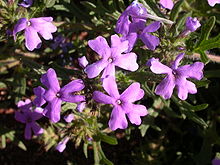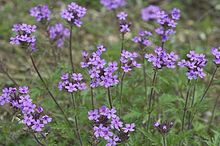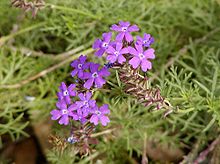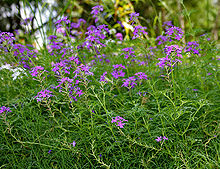- Glandularia
-
Mock vervains 
Glandularia bipinnatifida has chloroplasts acquired from a North American true vervain species via horizontal transfer. Scientific classification Kingdom: Plantae (unranked): Angiosperms (unranked): Eudicots (unranked): Asterids Order: Lamiales Family: Verbenaceae Genus: Glandularia
J.F.Gmel.Species Many, see text
Glandularia, called mock vervains or mock verbenas, is a genus of annual and perennial herbaceous flowering plants in the vervain family, Verbenaceae. They are native to the Americas.
Closely related to the true vervains[1] and sometimes still included with them in Verbena, horizontal chloroplast transfer occurred at least twice and possibly thrice between these genera, which are otherwise rather too distinct to warrant unification. The discovery of the signal in the chloroplast genome was announced in 2008 by University of Washington researchers. Somehow, chloroplasts from V. orcuttiana, Swamp Verbena (V. hastata) or a close relative of these had admixed into the G. bipinnatifida germline. Although hybridization runs rampant in the true and mock vervains – the ancestors of the well-known Garden Vervain are quite obscure –, it does not seem to have been the cause of the cross-species gene transfer.[2]
In addition, the researchers discovered the signal of one more transfer event. This had introduced chloroplasts from an ancestral member of the Verbena lineage nowadays found in South America into Glandularia Although all members of the present genus can be distinguished to have a chromosome count of 5, the South American species are diploid, while polyploid hybrid Glandularia are very widespread from northern Central America northwards. The second genetic introgression must have occurred before the genus spread north, as species with the Verbena-like chloroplasts are found all over the Americas. Since the new chloroplast genes replaced the old ones, it may be that the possibly hybridogenic G. bipinnatifida actually underwent horizontal chloroplast transfer twice in its evolutionary history.[2]
Selected species[3]
- Glandularia alejandrana B.L.Turner
- Glandularia amoena (Paxton) Umber
- Glandularia araucana (Phil.) Botta
- Glandularia aristigera (S.Moore) Tronc.
- Glandularia aurantiaca (Speg.) Botta
- Glandularia bajacalifornica (Moldenke) Umber
- Glandularia ballsii (Moldenke) Botta
- Glandularia bipinnatifida (Nutt.) Nutt.[verification needed]
- Glandularia brachyrhynchos G.L.Nesom & Vorobik
- Glandularia cabrerae (Moldenke) Botta
- Glandularia canadensis (L.) Nutt.
- Glandularia cheitmaniana (Moldenke) Botta & Poggio
- Glandularia chiracahensis Umber
- Glandularia crithmifolia (Gillies & Hook. ex Hook.) Schnack & Covas
- Glandularia delticola (Small) Umber
- Glandularia dissecta (Willd. ex Spreng.) Schnack & Covas
- Glandularia elegans (Kunth) Umber
- Glandularia flava (Gillies & Hook. ex Hook.) Schnack & Covas
- Glandularia glandulifera (Moldenke) Ragonese
- Glandularia gooddingii (Briq.) Solbrig
- Glandularia gooddingii var. gooddingii
- Glandularia gooddingii var. nepetifolia Tidestrom
- Glandularia guaranitica Tronc.
- Glandularia hasslerana (Briq.) Tronc.
- Glandularia herteri (Moldenke) Tronc.
- Glandularia hookeriana Covas & Schnack
- Glandularia × hybrida (hort. ex Groenl. & Rümpler) G. L. Nesom & Pruski – Hybrid Verbena, Garden Vervain (often placed in Verbena)
- Glandularia incisa (Hook.) Tronc.
- Glandularia kuntzeana (Moldenke) Tronc.
- Glandularia laciniata (L.) Schnack & Covas
- Glandularia lilacina (Greene) Umber
- Glandularia lilacina cv. 'De La Mina'.
- Glandularia lilloana (Moldenke) Botta
- Glandularia lipozygoides (Walp.) L.E.Navas
- Glandularia macrosperma (Speg.) Tronc.
- Glandularia maritima (Small) Small
- Glandularia marrubioides (Cham.) Tronc.
- Glandularia megapotamica (Spreng.) Cabrera & G.Dawson
- Glandularia mendocina (Phil.) Covas & Schnack
- Glandularia microphylla (Kunth) Cabrera
- Glandularia nana (Moldenke) Tronc.
- Glandularia origenes (Phil.) Schnack & Covas
- Glandularia parodii Covas & Schnack
- Glandularia perakii Covas & Schnack
- Glandularia peruviana (L.) Small
- Glandularia phlogiflora (Cham.) Schnack & Covas
- Glandularia platensis (Spreng.) Schnack & Covas
- Glandularia polyantha Umber
- Glandularia pulchella (Sweet) Tronc.
- Glandularia pulchra (Moldenke) Botta
- Glandularia pumila (Rydb.) Umber
- Glandularia quadrangulata (A.Heller) Umber
- Glandularia radicata (Moldenke) Tronc. ex Mulgura
- Glandularia santiaguensis Covas & Schnack
- Glandularia scrobiculata (Griseb.) Tronc.
- Glandularia selloi (Spreng.) Tronc.
- Glandularia sessilis (Cham.) Tronc.
- Glandularia spectabilis (Moldenke) Botta
- Glandularia stellarioides (Cham.) Schnack & Covas
- Glandularia subincana Tronc.
- Glandularia sulphurea (D.Don) Schnack & Covas
- Glandularia tampensis (Nash) Small[verification needed]
- Glandularia tenera (Spreng.) Cabrera
- Glandularia teucriifolia (M.Martens & Galeotti) Umber
- Glandularia tristachya (Tronc. & Burkart) Schnack & Covas
- Glandularia tumidula (L.M.Perry) Umber
- Glandularia turneri G.L.Nesom
- Glandularia venturii (Moldenke) Botta
- Glandularia verecunda Umber
Footnotes
References
- Botta, S.M.: Martinez, S. & Mulgura de Romero, M.E. (1995): Novedades nomenclaturales en Verbenaceae ["Nomenclatural revisions in Verbenaceae"]. Hickenia 2: 127-128.
- United States Department of Agriculture (USDA) (1999): Germplasm Resources Information Network - Glandularia. Version of 1999-AUG-30. Retrieved 2008-AUG-07.
- United States Department of Agriculture (USDA) [2008]: USDA Plants Profile: Verbena bonariensis. Retrieved 2008-AUG-07.
- Yuan, Yao-Wu & Olmstead, Richard G. (2008): A species-level phylogenetic study of the Verbena complex (Verbenaceae) indicates two independent intergeneric chloroplast transfers. Mol. Phylogenet. Evol. 48(1): 23-33. doi:10.1016/j.ympev.2008.04.004 (HTML abstract)
Categories:
Wikimedia Foundation. 2010.



